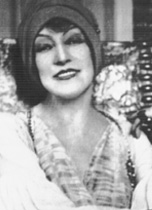The Gurdjieff Legacy Foundation Archives
Georgette Leblanc (1869–1941)

Georgette Leblanc was born in 1869 in Rouen, France, into a cultured family that valued the arts. She died in 1941 at Le Cannet, near Cannes.
A French operatic soprano, actress, author and sister of the novelist Maurice Leblanc, she was a much admired interpreter of Jules Massenet's works. Her professional opera debut took place at the Opera Comique in 1893.1
She also appeared in French films, notably L'Inhumaine, translated as The Inhuman Ones or The Inhuman Woman (1923), which she commissioned and helped to finance.2 In 1916 she played the role of Lady Macbeth in the film Macbeth.3
In 1895 she met the Belgian playwright Maurice Maeterlinck, who wrote several plays for her, including Monna Vanna (1902) and Ariane et Barbe-bleu (1899 and 1907). Previous to meeting Maeterlinck, Leblanc had married a Spanish man; her appeal for a divorce was denied by the Catholic Church. Leblanc then became Maeterlinck's mistress for 23 years. The two lived in Paris, entertaining the artistic community of the time.4 However, the relationship with Maeterlinck was not to last; in 1911 his attention was drawn to a younger woman who eventually moved in with them. In 1919 Georgette left him.5
In 1923, at the invitation of Hearst newspapers, Leblanc departed for America where she was to give recitals to introduce her to the public so that her memoirs could be sold. But soon her career began to falter. By 1924, her career at a standstill, she met Margaret Anderson, founder and editor of the Little Review and also a concert pianist, who encouraged her to resume her career and became her accompanist. They toured the United States to critical acclaim. Leblanc and Anderson were never to part. Anderson said of her, "There is something perfect in her soul."6
In February 1924 she attended a performance of Gurdjieff's dances in New York and the following June left for the Prieuré in Fontainebleau on Avon, together with Anderson, Jane Heap, Louise Davidson, and Leblanc's friend and housekeeper, Monique Serrure. Her first impression was negative and she left soon after arriving. Reviewing her experience, she saw her reaction and returned.7 In her book La Machine à courage Leblanc says she lived at the Prieuré uninterruptedly for two years.8
Along with Anderson, she later joined Jane Heap's group in Montmartre.9 She and Margaret Anderson, together with Monique Serrure, left Paris, staying at various chateaux belonging to Georgette's sister and her husband. In 1931 her book Souvenirs: My Life with Maeterlinck was published.10
On October 21, 1935, Gurdjieff started "the Rope," a group of special left bank women.11 An intense period of teaching began, the women meeting with him every day and reading aloud chapters of his unpublished First Series. At some point Leblanc and Anderson left Paris, but they received notes of the meetings from the women in the group, as well as typed copies of parts of Gurdjieff's book. Finally, in May 1936, Leblanc and Anderson returned to Paris to join the group.12
In 1939, just a few days after France and Britain declared war on Germany, Leblanc was diagnosed with cancer and underwent surgery on her arm, but the incision failed to heal.13 Leblanc, Anderson, and Serrure then left Paris. Not able to obtain visas for Portugal, an embarkation point for America, the three women were forced to flee from the war raging in Europe, moving from one place to another in Normandy, in and out of occupied zones, often with little or no money.14 Anderson's friend Ernest Hemingway sent $400 in remembrance of old times.15 In November 1939, Leblanc's Story of the Blue Bird was published.16
Finally, in 1940, Leblanc, Anderson, and Serrure moved to a tiny house, Le Chalet Rose, near Cannes.17 There, after long suffering, during which her work on herself was relentless, she died, in 1941, at the age of 72. She was buried in the Notre Dame des Anges Cemetery. Both Margaret Anderson and Monique Serrure were later buried near her.
At the end Gurdjieff had written to her saying she had "much courage" and she was a "friend." Said Margaret Anderson of her, "She had always shown us how to live, now she was showing us how to die."18
Leblanc's book La Machine à courage, written during her illness, was published in 1947.19
Notes
1. "Georgette Leblanc" http://en.wikipedia.org/wiki/Georgette_Leblanc.
2. "L'Inhumaine" http://www.classichorror.free-online.co.uk/i.htm.
3. "Georgette Leblanc" http://en.wikipedia.org/wiki/Georgette_Leblanc.
4. Ibid.
5. William Patrick Patterson, Ladies of the Rope (Fairfax, CA: Arete Communications, 1999), 10.
6. Ibid., 57.
7. Patterson, 11.
8. Georgette Leblanc, La Machine à courage (J.B. Janin, 1947). Extracts from the book at
http://www.Gurdjieff-Bibliography.com , 5.
9. Patterson, 12.
10. Patterson, 272.
11. This date according to Patterson, Ladies of the Rope, 272, or in early 1936 according to James Moore,
Gurdjieff: A Biography (Boston: Element, 1999), 261.
12. This date according to Patterson, Ladies of the Rope, 272, but Anderson in her The Fiery Fountains, 142,
mentions April 1935 as the time when she and Georgette left Vernet to join Gurdjieff in Paris.
13. Patterson, 154–56.
14. Margaret Anderson, The Fiery Fountains (New York: Horizon Press, 1969), 32.
15. Ibid., 223.
16. Patterson, 273.
17. Ibid.
18. Ibid., 235.
19. Ibid., 274.